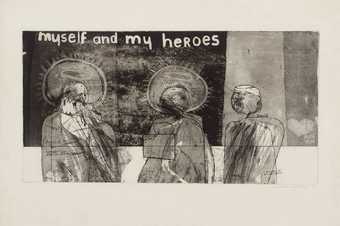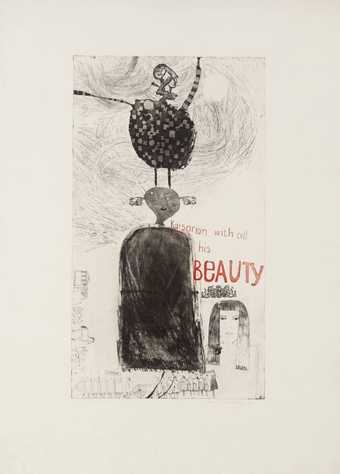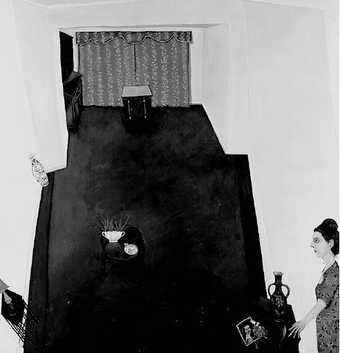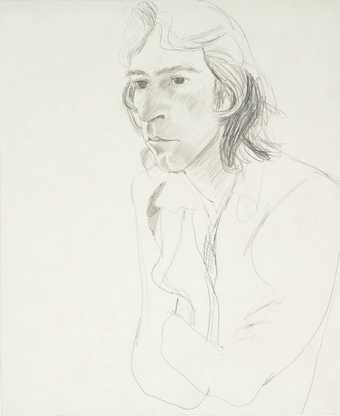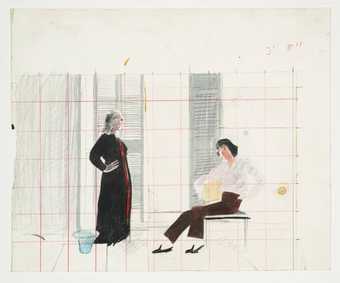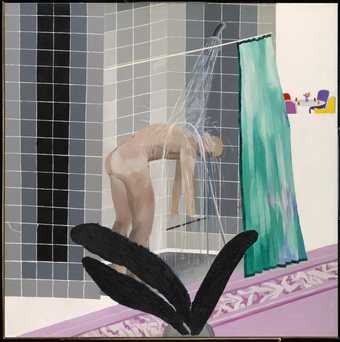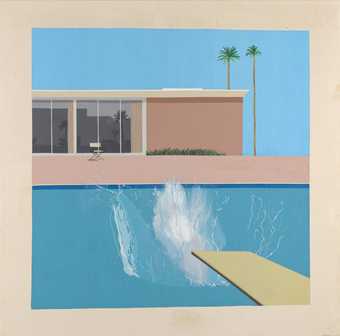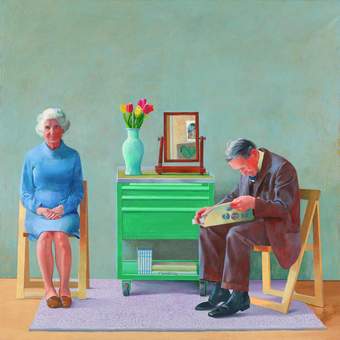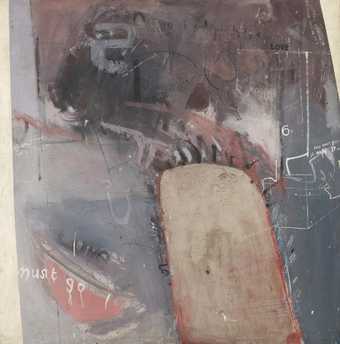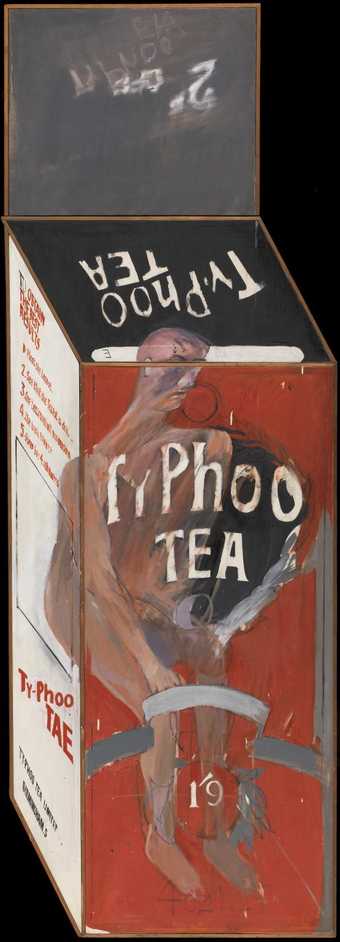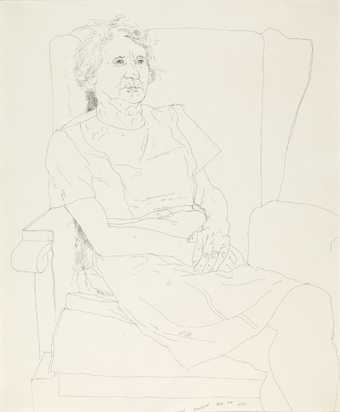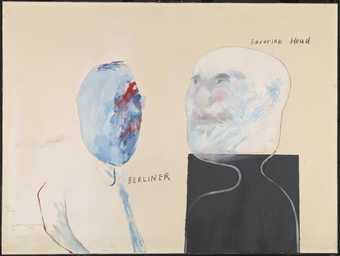
On loan
Museum of Contemporary Art Tokyo (Tokyo, Japan): David Hockney, in collaboration with the Hockney Studio
- Artist
- David Hockney born 1937
- Medium
- Acrylic paint on canvas
- Dimensions
- Support: 2134 × 3048 mm
frame: 2170 × 3084 × 58 mm - Collection
- Tate
- Acquisition
- Presented by the Friends of the Tate Gallery 1971
- Reference
- T01269
Summary
This is one of a series of large double portraits which Hockney began in 1968. He had painted imaginary couples in such earlier paintings as The First Marriage (A Marriage of Styles) 1963 (Tate T00596). In the later paintings, the subjects are real couples who were Hockney’s friends. They are portrayed in their home environment in a style which is both realistic and highly simplified. Hockney worked from photographs and life observation, making drawings to resolve composition. Usually one character looks at the other, who looks out of the painting at the viewer, thus creating a cyclical movement of looking. Mr and Mrs Clark and Percy is unusual in that both subjects, Mr and Mrs Clark, look out at the artist and viewer from either side of a large open window which is in the centre of the painting. The viewer, who looks at the painting from a central perspective, will be at the apex of the couple’s gaze out of the painting, a third in the relationship. Percy is the name of one of the Clarks’ cats and refers to the cat sitting statue-like on Mr Clark’s knee, looking out of the window. ‘Mr and Mrs Clark’ are the dress designer Ossie Clark and the fabric designer Celia Birtwell. Like Hockney, the two came from the north of England and met the artist in 1961 in Manchester, where Ossie was studying at Manchester College of Art. Both men went on to study at the Royal College of Art in London. When Ossie and Celia married in 1969, Hockney was their best man. He painted them in their flat in Notting Hill Gate, west London, an area where the artist and a number of his friends then lived. Hockney chose to paint them in their bedroom because he liked the light there. An etching from his earlier series A Rake’s Progress 1961–3 (Tate P07029-44) is portrayed on the left side of the painting. He began to make drawings and take photographs for the painting in 1969 and began working on the canvas in the spring of 1970, completing the painting in early 1971. In 1976 he described the painting as one of two works of his to come close to naturalism (Kinley 1992), although many areas of the image have been flattened and emptied of detail.
Hockney has commented that his aim in this painting was to ‘achieve … the presence of two people in this room. All the technical problems were caused because my main aim was to paint the relationship of these two people.’ (Quoted in Kinley 1992, [p.6].) One technical problem was to paint the figures contre jour, or against the light, something he had been experimenting with in earlier pictures of single figures in interiors. As in a photograph, it was difficult to achieve a balance between the bright daylight outside the window and the relative shade indoors. Because the canvas was so big, Hockney worked on it in his studio, where he set up light conditions that approximated those in the Clarks’ bedroom. He painted the lilies, sitting in a vase on a small table in the foreground of the painting, from life at the studio. He found the nearly life-size scale of the figures difficult to realise and both Clarks posed for him many times. In the event, Hockney painted Ossie Clark’s head as many as twelve times before he was satisfied. He is depicted lounging on a chair, his bare feet buried in the long pile of a fur rug. His pose is relaxed but his expression is watchful. Celia stands with one hand on her waist wearing a long, flowing dress and a rather wistful expression. Close to her and therefore, perhaps, associated with her are the lilies, traditionally a symbol of the Annunciation and feminine purity. Likewise, the cat on Ossie’s lap carries symbolic resonances of the libertine and somebody who disregards rules and does as they please. Viewed in this way, Mr and Mrs Clark and Percy recalls the famous portrait of a married couple, The Arnolfini Marriage 1434 (National Gallery, London) by Flemish renaissance painter Jan van Eyck (approximately 1395–1441), in which a small dog at the couple’s feet represents fidelity. Hockney has pointed out that his painting reversed one of the conventions of wedding portraiture, by seating the man while the woman stands. The gulf between the couple represented by the open window and the gaze of the third party (artist or viewer) turned out to be prophetic: the marriage did not last.
Further reading
Stephanie Barron, Maurice Tuchman, David Hockney: A Retrospective, exhibition catalogue, Los Angeles County Museum of Art, Metropolitan Museum of Art, New York and Tate Gallery, London 1988, p.37.
Catherine Kinley, David Hockney: Seven Paintings, exhibition brochure, Tate Gallery, London 1992, [p.6], reproduced [p.6] in colour.
Catherine Kinley, Hockney: Mr and Mrs Clark and Percy, exhibition brochure, Tate Gallery, London 1995, reproduced on front cover in colour.
Catherine Kinley/Elizabeth Manchester
1992 and 1995/March 2003
Does this text contain inaccurate information or language that you feel we should improve or change? We would like to hear from you.
Display caption
Hockney painted this portrait of his friends, fashion designers Ossie Clark and Celia Birtwell, shortly after their wedding. Hockey had been best man. The couple are shown in their flat, with their cat Percy, but they modeled for the work in Hockey’s studio multiple times. Hockey spent a lot of time working on the scene, and painted Ossie’s head at least twelve times until he was satisfied with it. Speaking about the painting in 2017, Birtwell said ‘David couldn’t get Ossie’s feet, so I think the rug was useful in the end’. Birtwell modelled for Hockney for many years.
Gallery label, July 2020
Does this text contain inaccurate information or language that you feel we should improve or change? We would like to hear from you.
Features
Explore
- architecture(30,960)
-
- features(8,872)
-
- balustrade(96)
- window(1,047)
- townscapes / man-made features(21,603)
-
- street(1,623)
- domestic(1,795)
-
- living room(292)
- electrical appliances(404)
-
- telephone(147)
- book - non-specific(1,954)
- vase(287)
- actions: postures and motions(9,111)
-
- hand / hands on hip(121)
- sitting(3,347)
- standing(3,106)
- Birtwell, Celia(8)
- Clark, Ossie(3)
- individuals: female(1,698)
- individuals: male(1,841)
- UK countries and regions(24,355)
-
- England(19,202)
- Notting Hill(11)
- industrial and crafts(1,327)
-
- designer(300)
You might like
-
David Hockney Myself and my Heroes
1961 -
David Hockney Kaisarion and All his Beauty
1961 -
David Hockney Beautiful and White Flowers
1966 -
Anthony Green Souvenir de Jeunesse: Madeleine Joscelyne’s Lounge
1967 -
David Hockney Study for ‘Mr and Mrs Clark and Percy’
1970 -
David Hockney Study for ‘Mr and Mrs Clark and Percy’
1970 -
David Hockney Man in Shower in Beverly Hills
1964 -
David Hockney A Bigger Splash
1967 -
David Hockney My Parents
1977 -
David Hockney The Third Love Painting
1960 -
David Hockney Tea Painting in an Illusionistic Style
1961 -
David Hockney Portrait of the Artist’s Mother, Mrs Laura Hockney, Bradford
1972 -
David Hockney Study for Doll Boy
1960 -
David Hockney The Berliner and the Bavarian
1962 -
David Hockney George Lawson and Wayne Sleep
1972–5

